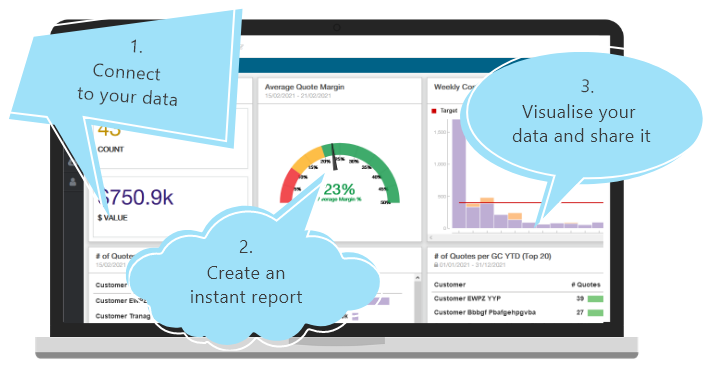Best practices for ServiceTitan Pricebook naming conventions
Do you wish that your ServiceTitan Pricebook told a clearer, more comprehensive story about your services? Pricing data goes beyond numbers. If you want to optimize your pricebook, it’s important to get both right on a consistent basis: the price of an item and everything it includes.
In this article, we dig around the best practices for naming conventions and descriptions of your ServiceTitan Pricebook items. And we wonder out loud if all this effort will fit its purpose.
Why your pricebook needs a naming convention
What you call a service or product and how you describe it matters, because it brings your pricebook:
- Consistency - it enables everyone on your team to speak with one voice as pricing info is consistent across all areas of the business, projecting a professional image; it guides and speeds up the addition of new items.
- Efficiency - it categorizes your pricebook to help staff members locate the items they wish to add to estimates, quotes or invoices easily and quickly.
- Clarity - it helps your technicians sell better while providing your customers with a reliable buying experience.
When your technicians are out on service calls, they have a limited amount of time to make a recommendation or a sale. A well-organized pricebook saves time and helps them to pitch that sale more effectively. Where there's precision, there's confidence in what's being sold and how to cost a particular service. It needs to be simple enough to explain to customers what that service/product is, what it does and why they need it.
Your customer may expect to be bamboozled by technical terminology, which doesn’t help the relationship. Present your services, equipment and materials to customers in a succinct way that removes doubt about what the price includes, and immediately improve their purchasing experience.
This clarity of what a service call will entail and why the equipment listed in an estimate is required, has the subtle power to instill trust in the customer, giving you the edge over your competition.
Where to enter pricing item names and descriptions
The fun starts on your ServiceTitan Pricebook Excel spreadsheet. By this stage, you should already have set up your categories and subcategories. The Excel doc is where you flesh out pricing information.
You’ll notice a number of tabs with lots of fields to complete. It’s a good idea to consider before you start entering info if you'll customize any elements and which optional parts you will edit or omit. For example, using your own item codes. Just beware of using codes that differ from supplier item codes. Definitely leave Id’s be or anything else that’s system-generated if you want to avoid import errors.
Categories tab
- Add a name for each item in categories 1 and 2 depending on its designation
- Add a category description
- Add images and/or a video
Equipment tab
- Add a category name if you want the item to display on ServiceTitan Mobile.
- Name and describe it in 32,000 characters or less.
- Enter the expected length of time it takes to install or use this equipment under ‘Hours’.
- Insert the manufacturer, model number and cost.
There’s a range of optional info to add, from warranty details to units of measurement to inventory availability. Again, decide beforehand what info you want to provide as standard, then ensure you apply the formula across your Pricebook for consistency.
Services tab
Has much the same fields as the equipment tab in terms of category, name and description:
- Add upgrade options for ‘good, better, best’ comparisons.
- Add minimum labor hours to set expectations on the length of time it takes.
Materials tab
Has the same fields as previous tabs, except:
- Add vendor part numbers for replenishment purposes.
Assets tab
Here you can add PDFs of warranties, brochures and catalogs to enhance the customer experience. Technicians can show these from their mobile devices.
Best practices for pricebook descriptions
All of the above is really the framing for your pricing item. Now, ensure your ServiceTitan Pricebook is fit for purpose by combining a succinct, instructive product or service description with accurate labeling and visual content. 32,000 characters is as much as it sounds. Detail is important; so is simplicity.
There’s a lot to balance: oversimplifying with super short, abbreviated naming and description can come across vague and open to misinterpretation. It loses the opportunity to educate both customers and apprentices among your team, setting zero expectation of the amount of work and time it’s meant to take to complete a job. Adequate detail helps techs maintain good service levels.
Take the time to choose words that match the customer’s level of understanding - less jargon means they better understand what they see on the estimate as they make the decision to give you the job of replacing or fixing that faulty motor in their HVAC system. It also encourages them to invest in memberships because they can easily access content that’s relevant to them in formats they can understand and essentially help themselves plan their next purchase.
Here's an important little factoid for you: folks just don’t love a bunch of text. We’re dealing with an ever shorter attention span and a preference to get straight to the point. Reach your customer in a way that suits their learning style. Did you know that people generally process visual info faster than text-based info? Showing complements telling. So, for optimal impact, combine the two in a 20:80 ratio.
80% Visual content
- Photographs or illustrations to describe equipment to be installed
- Diagrams to illustrate processes
- YouTube videos to demonstrate services in action
20% Text
- Think bulleted points, bold text for emphasis, and enough white space to break it all up, for easy scanning.
- Lean into the active voice for simpler, more economical sentences. More ‘this is what the technician will do’; less ‘this function will be performed by the technician’.
- Use the imperative form of the verb for a more concise way to label services, as in ‘Replace faulty motor’.
- Focus on how the item benefits the customer, on use cases where the item would be useful, and highlight features or specs.
- Be clear, be brief, be relevant.
Maintaining consistency in your pricebook
As it stands, your ServiceTitan Pricebook is not fully dynamic. Once uploaded, your descriptions together with all pricing info goes static. You have to check your Pricebook for change notifications, especially with supplier items, in order to avoid inconsistencies. Anyone in your company that uses it (that’s everyone, right?) - including the techs that use the mobile output - should get into the daily habit of downloading your ServiceTitan Pricebook and synching changes. This way, any changes your admin guy makes will become available to all users - including prices, names, descriptions and assets.
Matching up your own descriptions with those of your suppliers is an important decision to make at the point of adding the items you need to your ServiceTitan Pricebook. Otherwise there’s too much room for error, inconsistency, and confusion.
- Once you download an item from a supplier catalog, you can edit it in your pricebook but remember if the supplier changes any part of that item’s pricing info, it won’t reflect in your pricebook. A change notification will alert you to make the necessary update in your Pricebook.
- You’re limited in terms of what supplier catalog item fields you can edit in your pricebook - everything but the category and subcategory names, and equipment item model and manufacturer. If you have Pricebook Pro, add the item name and code to that list (unless you duplicate the item, then all fields are fair game).
- With these limitations and exceptions, it can get messy if you’re not careful, especially about editing permissions. Admins can accidentally (or purposefully) revert back to the supplier catalog version of an item’s pricing info, which can confuse things if you’ve otherwise opted for custom product descriptions and content.
Or, simply automate your ServiceTitan Pricebook!
Why? So that any changes in supplier pricing information will automatically reflect in your own pricebook. Because there’s no cause for duplication and custom edit errors. Because it’s the most efficient way to maintain consistent pricing data. And because the other way takes too long and sounds like too much hard work.
How? By connecting to Wink Reports. We partner with ServiceTitan to help users optimize their Pricebook. We set up the integration with your supplier, connect to their API, and our automation pushes supplier pricing info directly into your ServiceTitan account. All the info you’ll have is up-to-date, correct, and consistent.
Sign up to Wink here for a ServiceTitan Pricebook that’s fit for purpose.

.png?width=900&height=450&name=Hubspot%20Blog%20Header%20Banner_1%20(900%20x%20450%20px).png)



